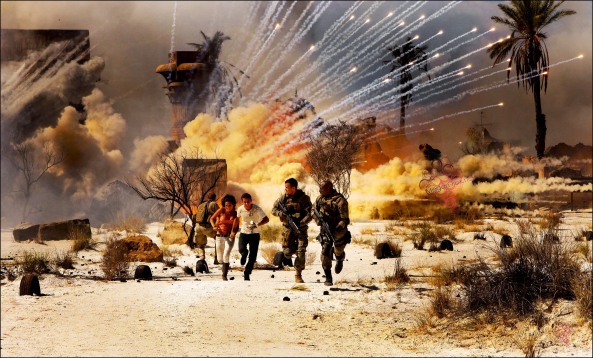“Haywire” looks strikingly different from most other modern action movies. What has the action genre become in the 2000s?
There’s something depressing about watching Gina Carano kick ass in “Haywire” and then watch her lose a fight against Cris Cyborg on YouTube.
Both Carano’s movie fights and her actual work as a martial artist are gut-wrenching in their skill and toughness, but the stylized minimalism of “Haywire” is really nothing like something you would see in the Octagon.
It got me thinking how impressed I was by the craft and choreography incorporated by Steven Soderbergh. He described his style in an interview with the A.V. Club. (read the full interview here)
“We had people who could really fight, so I wanted the camera to be stationary, and through editing and movement with the camera on a dolly,” Soderbergh said. “I wanted to use wide lenses and looser shots than you’d typically see when you’re shooting action.”
But the more I thought about it, I thought about how far back I’d have to go to actually find a modern action movie that looks or feels anything like it. “Crouching Tiger, Hidden Dragon?” “The Matrix?” “Enter the Dragon?”
What is the modern action movie, and is it any good? Here I’ve described a few styles and the movies that influenced them, for better or worse.

“Lord of the Rings” and The Action Extravaganza
In the 2000s there was one action movie to rule them all, and that was “The Lord of the Rings.” Peter Jackson combined brutal but fun and bloodless PG-13 action with J.R.R. Tolkien’s sweeping fantasy scope and had an instant hit.
The wars in the last two films specifically raged on endlessly to great effect, but movies as diverse as “Avatar,” “Star Trek” and “District 9” took that to mean an epic battle could substitute for a third act. Even dramas like the much-maligned “Alice in Wonderland” seemed to forget how to write a satisfying conclusion without every character fighting a pointless war.

“V for Vendetta” and The Style Junkie
“V for Vendetta” didn’t just attain cult status because of its rebellious message. Its hyper stylized aesthetic, one that borrowed from “The Matrix’s” bullet-time effects and incorporated explosions of light, color, CGI and more explosions, was unlike anything anyone had ever seen.
It wasn’t long before Zack Snyder used the look as a template for all graphic novel movies, and even worse copycats started making completely unnecessary and lame CGI universes in something like the undying “Resident Evil” franchise.

“The Bourne Supremacy” and The Grittily Realistic
The first Bourne movie was fun and all, but the series really became popular when Paul Greengrass took the helm on the second and third sequels. His films made use of a handheld camera as a method of conveying dirty, down-to-Earth visuals and jerky, energetic motion. Jason Bourne’s fights were quick and capitalized more on sound than clear visuals to deal the killing blow.
But the queasy cam has quickly gotten out of hand, resulting in hard to process action sequences without a coherent sense of cinematic space. Even Greengrass overused it in his modern warfare film “Green Zone,” and other Iraqi War movies have followed suit. The style has even migrated over into horror movies like “Cloverfield.”

The Bigger Picture
All three of these styles have come to define the modern action movie in one way or another, and it’s strikingly different from “Die Hard,” “Terminator 2,” many of the Bond movies or countless more.
And some movies share all three traits to varying levels of success. When the styles are all combined well, you can get something like “The Dark Knight” or “Inception.” When they aren’t, “Transformers” is the resulting mess.
Superheroes and their batch of special effects driven action are dominating right now, so filmmakers often make a point to distance themselves from those styles. Quentin Tarantino modeled “Kill Bill” off exploitation and Kung-Fu films, “Fast Five” and the latest “Mission: Impossible” go out of their way to avoid special effects, and thrillers like “Drive” and “The Hurt Locker” are occasionally expressions of minimalism.
While some of these films are invigorating reasons to go to the movies, others can be tiresome, so it’s about time someone beat the action film into shape.



